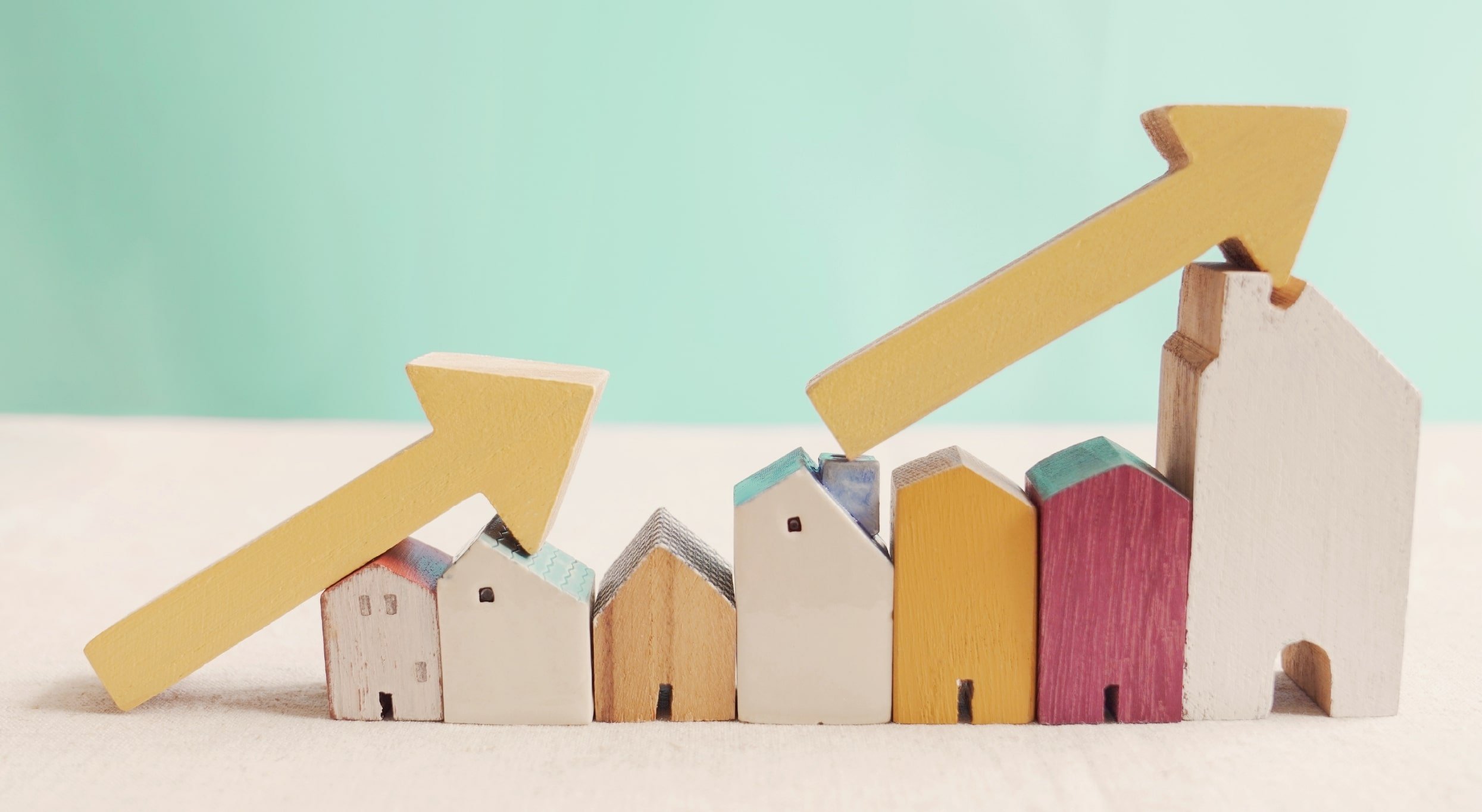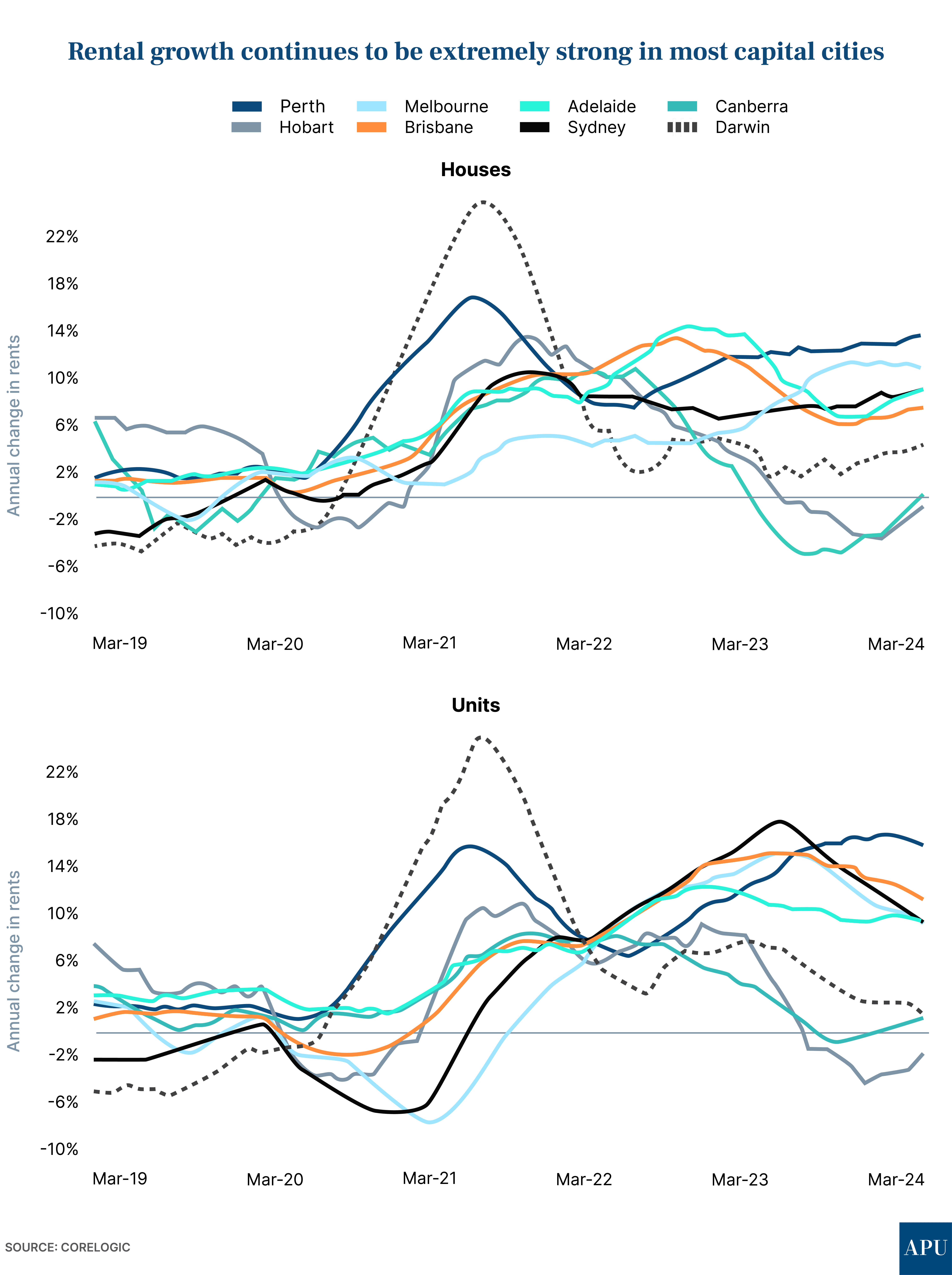Features > Property News & Insights > Housing Trends
On track for another year of solid property price growth

KEY POINTS
- Home prices rose 0.6% in March, taking this year’s national gains so far to 1.6%, according to CoreLogic
- It’s a mixed picture across the country however, with Perth values increasing 1.9% in just a month, with Sydney subdued at 0.3%, Melbourne flat and Darwin prices easing at 0.2%
- Residential property values have now been growing nationally for 14 months straight
- While property prices have remained subdued in Melbourne, surging rents have seen rental yields soar for property investors in the Victorian capital
New figures from CoreLogic show Australia’s residential property market is on track for another year of solid gains, despite a cost of living crisis, a per capita recession, and the highest interest rates in more than a decade.
CoreLogic's national Home Value Index (HVI) rose 0.6% in March, following a similar rise the previous month, and taking this year’s gains so far to 1.6%, in effect adding around $12,000 to the price of a median home, just since the 1st of January.
March was the 14th straight month of gains in housing prices.
If those monthly results continue to be replicated, Australia is on track to record growth of at least 6.5-7% this year, and that’s before an expected upswing in housing prices following forecast interest rate cuts in the second half of the year.
The nitty-gritty

Once again, CoreLogic’s monthly HVI figures show a mixed picture across the nation, ranging from a 0.2% easing in home prices in Darwin, to extremely strong monthly growth of 1.9% in Perth, 1.4% in Adelaide and 1.1% in Brisbane.
Growth was relatively subdued in Sydney at 0.3% in March, while there was no movement in Melbourne, which has actually seen home price growth go into negative territory (-0.2%) since the start of the year.
“The diversity in housing value outcomes can be explained by significant differences in factors like housing affordability, demand-side pressures from population growth and shortcomings in housing supply,” says CoreLogic’s Research Director Tim Lawless.
Pointing to the huge gains of just under 20% in home prices in Perth over the last 12 months, Mr Lawless says, “Despite such a rapid pace of capital gains, housing values remain relatively affordable compared with the larger capital cities.”
“Housing remains in short supply and purchasing demand is still high due to interstate and overseas migration rates that are well above average.”
Tim Lawless says recent population data from the Australian Bureau of Statistics showed net overseas migration to Western Australia was running well above average at 18,122 in the September quarter of last year (up from a decade average of 4,639 per quarter).
That’s been supplemented by net interstate migration, which is holding well above the previous decade average of -96, reaching 2,237 in the quarter.
“The extreme flip in demographic trends has delivered a significant positive demand shock across WA housing,” he says.
More broadly, CoreLogic’s research finds that the strongest housing growth conditions are now in the lowest quartile (or the cheapest 25% of homes on the market) across most capital city markets.
Across the combined capital cities, the lowest quartile home values increased by 3.1% in the first quarter of the year compared with a 0.7% rise across the upper quartile (or most expensive 25% of homes for sale).
“With housing affordability becoming more challenging and borrowing capacity lower than a year ago, it’s no surprise to see demand being skewed towards the middle-to-lower end of the value spectrum,” Mr Lawless said.
Investors take note: strong rental growth continues

CoreLogic now reports its national rental index was up 2.8% in the March quarter - that’s the fastest quarterly pace of rental growth since the three months ending May 2022 (2.9%).
It finds unit rents are continuing to rise faster than house rents across Australia’s combined capital cities, up 2.9% and 2.7%, respectively, in the March quarter.
With rents once again rising faster than housing values, CoreLogic’s Tim Lawless points to higher rental yields, which at 3.75%, are the highest since October 2019.
Interestingly, while home values in the Victorian capital have been sluggish, Tim Lawless says Melbourne has recorded one of the most significant lifts in gross rental yields, from 2.76% two years ago to reach 3.57% in March 2024, the highest gross yield in 8 years.
He says this can be attributed to a 4.1% fall in Melbourne dwelling values over the past two years, while rents in the southern city have surged 21.1% higher.
“A rise in rental yields alongside an expectation that housing values could rise and rental markets remain tight for an extended period of time is likely to be seen as an attractive opportunity for property investors,” Mr Lawless says.
Stay Up to Date
with the Latest Australian Property News, Insights & Education.




.png?width=292&height=292&name=Copy%20Link%20(1).png)
 SIGN UP FOR FREE NEWSLETTER
SIGN UP FOR FREE NEWSLETTER








.jpg?width=1920&height=1080&name=Warning%2c%20You%20Might%20Be%20Facing%20Higher%20Taxes%20Soon%20(1).jpg)





.png?width=1920&height=1080&name=Rate%20Drops%20Signal%20BIGGEST%20Property%20Boom%20in%20DECADES%20(1).png)

.jpg?width=1920&height=1080&name=Labor%20vs%20Liberal%20These%20Housing%20Policies%20Could%20Change%20the%20Property%20Market%20Forever%20(1).jpg)
.jpg?width=1920&height=1080&name=QLD%20Slashes%20Stamp%20Duty%20Big%20News%20for%20Investors%20%26%20Home%20Buyers%20(1).jpg)
.jpg?width=1920&height=1080&name=Trump%20Just%20Slapped%20Tariffs%20%E2%80%93%20Here%E2%80%99s%20What%20It%20Means%20for%20Australia%20(1).jpg)
.jpg?width=1920&height=1080&name=Federal%20Budget%202025%20More%20Debt%2c%20No%20Housing%20%E2%80%93%20Here%E2%80%99s%20What%20You%20Need%20to%20Know%20(1).jpg)
.jpg?width=1920&height=1080&name=Australias%20Housing%20Crisis%20is%20about%20to%20get%20MUCH%20Worse%20(New%20Data%20Warns).jpg)
%20(1).jpg?width=1920&height=1080&name=Australias%20RENTAL%20CRISIS%20Hits%20ROCK%20BOTTOM!%20(2025%20Update)%20(1).jpg)
%20(1).png?width=1920&height=1080&name=Is%20Adelaide%20Still%20a%20Good%20Property%20Investment%20(2025%20UPDATE)%20(1).png)
.jpg?width=1920&height=1080&name=RBA%20Shocks%20with%20Rate%20Cuts!%20What%E2%80%99s%20Next%20for%20Property%20Investors%20(1).jpg)
%20(1).jpg?width=1920&height=1080&name=I%20Predict%20The%20Feb%20Rate%20Cut%20(My%20Price%20Growth%20Prediction)%20(1).jpg)
.png?width=1920&height=1080&name=Why%20Property%20Prices%20Will%20Rise%20in%202025%20Market%20Predictions%20(1).png)
.jpg?width=1920&height=1080&name=Why%20Investors%20Are%20Choosing%20Apartments%20Over%20Houses%202%20(1).jpg)
.jpg?width=1920&height=1080&name=Why%20Rate%20Cuts%20Will%20Trigger%20A%20Property%20Boom%20(1).jpg)
.jpg?width=1920&height=1080&name=Retire%20On%202Million%20With%20One%20Property%20(Using%20SMSF).jpg)
.jpg?width=1920&height=1080&name=4%20Reasons%20Why%20You%20Should%20Invest%20in%20Melbourne%20Now%20(1).jpg)
%20(1).jpg?width=1920&height=1080&name=Old%20Property%20vs%20New%20Property%20(Facts%20and%20Figures%20Revealed)%20(1).jpg)
%20(1).jpg?width=1920&height=1080&name=Will%20The%20New%20QLD%20Govt%20Create%20a%20Property%20Boom%20or%20Bust%20(My%20Prediction)%20(1).jpg)
%20Scott%20Kuru%20(1).jpg?width=1920&height=1080&name=Inflation%20Hits%20Three-Year%20Low%20(Will%20RBA%20Cut%20Rates%20Soon)%20Scott%20Kuru%20(1).jpg)
.jpg?width=1920&height=1080&name=How%20to%20Buy%20Investment%20Property%20Through%20SMSF_%20The%20Ultimate%20Guide%20(1).jpg)
.jpg?width=1920&height=1080&name=Victoria%20Slashes%20Stamp%20Duty%20Melbourne%20Set%20to%20Boom%20Scott%20Kuru%20(1).jpg)
.png?width=1571&height=861&name=Are%20Foreign%20Buyers%20Really%20Driving%20Up%20Australian%20Property%20Prices%20(1).png)
.jpg?width=1920&height=1080&name=The%20Single%20Factor%20That%20Predicts%20Property%20Growth%20Regions%20(1).jpg)
%20Scott%20Kuru%20(1).jpg?width=1920&height=1080&name=My%20Prediction%20On%20Rates%20%26%20Negative%20Gearing%20(Market%20Crash)%20Scott%20Kuru%20(1).jpg)

-1.png?width=1920&height=1080&name=Major%20Banks%20Cut%20Rates%20Will%20RBA%20Follow%20Suit%20(Sept%20Rate%20Update)-1.png)
%20Scott%20Kuru-1.png?width=1920&height=1080&name=Rate%20Cut%20Coming%20What%20New%20Zealands%20Move%20Means%20for%20Australia%20(Sept%20Prediction)%20Scott%20Kuru-1.png)
%20(1).jpg?width=1920&height=1080&name=Buy%20when%20the%20interest%20rates%20are%20high!%20(Why%20you%20must%20buy%20now!)%20(1).jpg)
.jpg?width=1920&height=1080&name=Carms_Revised%20Taxes%20Due%20Aug%209%20YT%20Thumbnail02%20(1).jpg)
.jpg?width=1920&height=1080&name=Carms_Too%20Little%20Too%20Late%20Aug%207%20YT%20Thumbnail01%20(1).jpg)









.jpg?width=1920&height=1080&name=Carms_Rate%20Drop%20In%20July%20Jun%2010%20YT%20Thumbnail02%20(1).jpg)
.jpg?width=1920&height=1080&name=Carms_Own%20a%20Property%20V6%20Jun%205_YT%20Thumbnail%20(1).jpg)









.png?width=1920&height=1080&name=Artboard%201%20(3).png)






.jpg?width=1920&height=1080&name=YT%20thumbnail%20%20(1).jpg)

